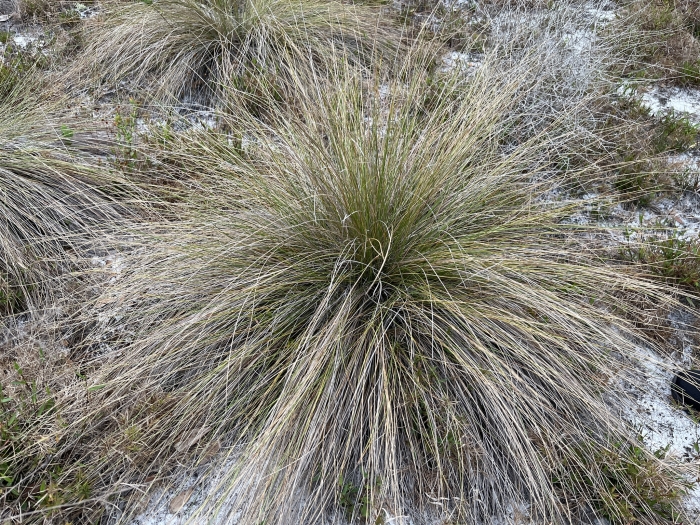Wiregrass
(Aristida stricta)
Wiregrass (Aristida stricta)
/
/

© Darren Oh
CC BY-SA 4.0
Image By:
© Darren Oh
Recorded By:
Copyright:
CC BY-SA 4.0
Copyright Notice:
Photo by: © Darren Oh | License Type: CC BY-SA 4.0 | License URL: http://creativecommons.org/licenses/by-sa/4.0/ | Uploader: darrenoh | Publisher: iNaturalist |

























Estimated Native Range
Summary
Aristida stricta, commonly known as wiregrass or pineland three-awn grass, is a perennial, warm-season grass native to the longleaf pine savannas and sandhill communities of the Southeastern United States, particularly in the Coastal Plain from Virginia to Florida and west to Louisiana. It is a key species in fire-dependent ecosystems, often growing to 2-3 feet in height. Wiregrass has a tufted growth form with fine, wiry leaves and distinctive three-pronged seed awns that can catch on animal fur for seed dispersal. The plant’s flowering season extends from late summer to fall, and while the flowers are not particularly showy, they are critical for seed production, which is enhanced by the plant’s adaptation to fire.
Wiregrass is valued for its role in ecological restoration and conservation of native grasslands. It is used to maintain the structure and biodiversity of its native habitat, which includes supporting the life cycles of many wildlife species. In cultivation, it requires full sun and is tolerant of poor, sandy soils with good drainage. It is relatively low maintenance but may not be suitable for all garden settings due to its specific ecological role. Wiregrass can be used in naturalistic plantings and as a ground cover in appropriate areas. Regular burning or mowing can mimic natural processes to encourage its growth and reproduction.CC BY-SA 4.0
Wiregrass is valued for its role in ecological restoration and conservation of native grasslands. It is used to maintain the structure and biodiversity of its native habitat, which includes supporting the life cycles of many wildlife species. In cultivation, it requires full sun and is tolerant of poor, sandy soils with good drainage. It is relatively low maintenance but may not be suitable for all garden settings due to its specific ecological role. Wiregrass can be used in naturalistic plantings and as a ground cover in appropriate areas. Regular burning or mowing can mimic natural processes to encourage its growth and reproduction.CC BY-SA 4.0
Plant Description
- Plant Type: Grass
- Height: 1-4 feet
- Width: 1-3 feet
- Growth Rate: Moderate
- Flower Color: N/A
- Flowering Season: Spring, Summer, Fall
- Leaf Retention: Deciduous
Growth Requirements
- Sun: Full Sun
- Water: Low
- Drainage: Fast, Medium
Common Uses
Bird Garden, Erosion Control, Fire Resistant, Groundcover, Low Maintenance
Natural Habitat
Native to longleaf pine savannas and sandhill communities within the Coastal Plain from Virginia to Florida and west to Louisiana
Other Names
Common Names: Wiregrass , Southern Wiregrass
Scientific Names: Aristida stricta , Aristida stricta var. stricta , Chaetaria stricta , Schizachne stricta
GBIF Accepted Name: